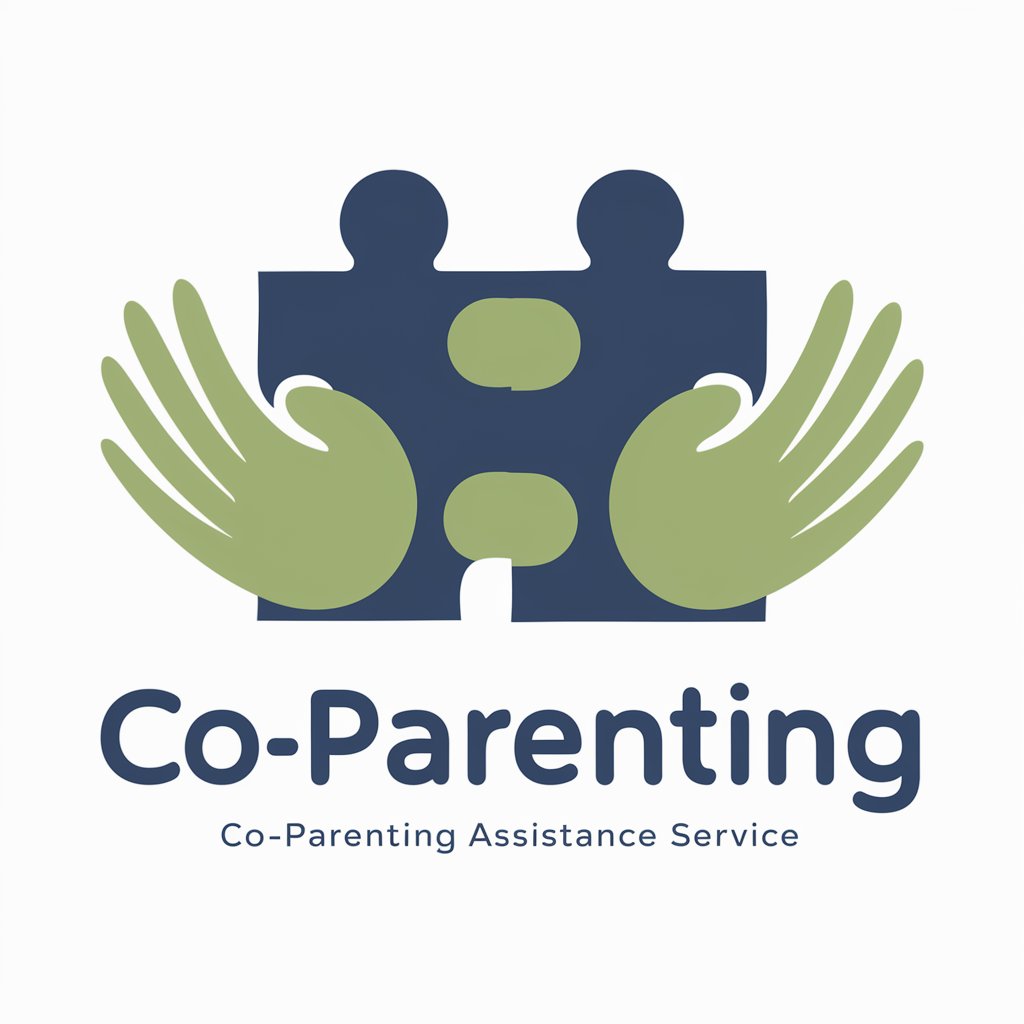Co-Parenting - AI-powered co-parenting tool

Welcome! I'm here to help with your co-parenting journey.
Streamline co-parenting with AI support
Can you help me manage a co-parenting schedule for my children?
What are some effective ways to communicate about shared expenses with my ex?
How can I make transitions between homes easier for my kids?
What tools or apps do you recommend for co-parenting?
Get Embed Code
Understanding Co-Parenting
Co-parenting is the collaborative process in which divorced or separated parents share the responsibilities of raising their children. The design purpose of co-parenting is to ensure children have stability and support from both parents, despite changes in the family structure. It involves communication, cooperation, and shared decision-making between parents to promote the well-being of their children. Co-parenting seeks to minimize conflict and provide a positive environment for the children. An example of co-parenting could be parents coordinating to ensure their child's medical needs are met, with one parent handling insurance and the other attending doctor's appointments. Another scenario might involve parents working together to celebrate their child's birthday by jointly planning a party or taking them out for a special event. Powered by ChatGPT-4o。

Key Functions of Co-Parenting
Communication
Example
Regularly updating each other about the child's activities, school progress, and any issues that may arise.
Scenario
Parents use a shared calendar or co-parenting app to stay informed about their child's schedule, ensuring there are no overlaps or missed appointments.
Cooperation
Example
Coordinating parenting styles, rules, and expectations to ensure consistency across households.
Scenario
Parents agree on consistent bedtimes and discipline methods, preventing confusion for the child and reducing parental conflict.
Shared Decision-Making
Example
Making major decisions about the child's education, health, and extracurricular activities together.
Scenario
Parents discuss and agree on which school their child will attend and collaborate on choosing after-school activities that suit the child's interests.
Conflict Resolution
Example
Finding amicable solutions to disagreements without involving the child or escalating conflict.
Scenario
Parents use mediation or a neutral third party to resolve disputes about holiday custody arrangements or other contentious issues.
Ideal Users of Co-Parenting
Divorced or Separated Parents
Parents who are no longer in a romantic relationship but wish to collaborate in raising their children. These users benefit from co-parenting as it allows them to maintain a stable and supportive environment for their children.
Blended Families
Parents who are part of blended families, where step-parents or new partners are involved. Co-parenting helps these families establish clear boundaries and communication channels.
Legal and Mediation Professionals
Professionals who work with families undergoing divorce or separation. Co-parenting information aids these professionals in advising their clients on best practices for maintaining a healthy co-parenting relationship.
Counselors and Therapists
Mental health professionals who support families through transitions. Co-parenting concepts help these professionals guide parents toward cooperative behavior and healthier family dynamics.

How to Use Co-Parenting
1
Start by visiting yeschat.ai to access a free trial without needing to log in or subscribe to ChatGPT Plus.
2
Set up your profile by entering basic information about your family structure, such as names and ages of children, to customize the tool's suggestions and reminders.
3
Utilize the scheduling feature to manage and synchronize parenting time, appointments, and events, ensuring both parents are informed and involved.
4
Use the expense tracker to record and share costs related to child care, medical expenses, and extracurricular activities, facilitating transparent and fair financial management.
5
Engage with the communication log to maintain a clear and documented history of conversations and decisions, which can help reduce misunderstandings and improve collaboration.
Try other advanced and practical GPTs
PhD Project Assistant
Automating your PhD proposal process

Persona Craft
AI-powered Customer Insight Discovery

Cheat Day
Estimate calories, burn them playfully!

Marketing Coach MindHacker.AI
Empowering Marketing Success with AI

D&B Explorer
Explore drum and bass with AI.

Pronúncia do Alemão (pt_BR) Deutsche Aussprache
Master German pronunciation with AI-powered guidance.

English Tutor Bot
Empowering Young Minds with AI

My Cultural Insight
Harness AI for Global Cultural Insights

Tutor Pessoal de Persa (Farsi)
Empowering Persian Learning with AI

Cutting Edge Tech Explorer
Empower your tech journey with AI-powered exploration.

निजी अरबी ट्यूटर
Master Arabic with AI Guidance

Kişisel Endonezce Öğretmeni
Master Indonesian with AI-powered guidance.

Frequently Asked Questions About Co-Parenting
How can Co-Parenting help in managing shared expenses?
Co-Parenting includes an integrated expense tracker that allows parents to log, share, and review expenses. This tool aids in ensuring financial responsibilities are met equitably and transparently.
What makes Co-Parenting unique compared to other similar tools?
Co-Parenting distinguishes itself by offering AI-powered suggestions for resolving common co-parenting disputes and optimizing scheduling, tailored to each family's specific needs and dynamics.
Is Co-Parenting suitable for parents in different geographical locations?
Yes, Co-Parenting is designed to support parents regardless of their geographical locations, providing features like time zone adjustments and remote access to shared calendars and documents.
Can Co-Parenting be used for legal disputes?
While Co-Parenting can document communications and agreements which may be useful for legal reference, it is not a substitute for legal advice. For legal disputes, consult a qualified attorney.
How does Co-Parenting ensure the privacy and security of its users?
Co-Parenting employs advanced security protocols, including data encryption and secure server connections, to protect the personal and sensitive information of its users.
